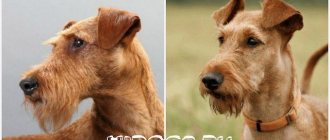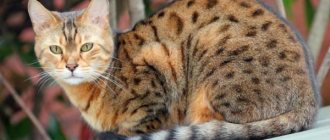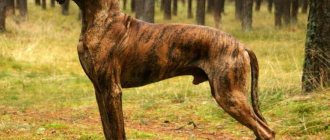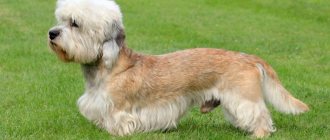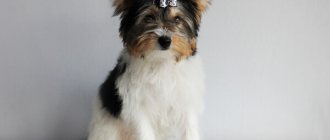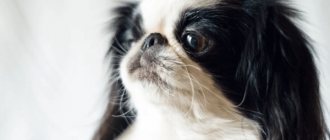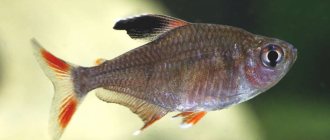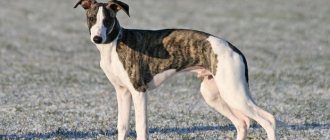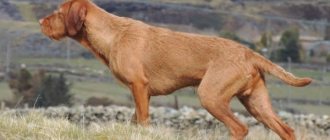Brief characteristics of the dog
- Other possible names: Jones Terrier, Norwich Terrier, Trumpington Terrier, Cambridge Terrier.
- Adult height: 25-26 cm.
- Weight: standard 5-6 kg.
- Characteristic color: gray, straw or red, black.
- Coat length: medium, hard.
- Life expectancy: on average 12-14 years.
- Advantages of the breed: good-natured, cheerful, intelligent, brave.
- Breed Difficulties: Very active.
- Average Price: Norwich Terrier costs between $1,000 and $2,500.
History of the origin of the breed
The Norwich Terrier is the smallest dog of all terriers. The breed was developed in the southeast of England in the second half of the 19th century, when it was fashionable in Europe to breed dogs. One day, a lover of small terriers, Sir H. Cole, gave birth to red puppies from his fox terrier.
He gave several puppies to his friend and also a dog lover, Frank Jones. When the dogs grew up, Frank crossed them with his dog, who was already an Aberdeen terrier mix. Subsequently, the dogs were inoculated with the blood of the Border Terrier, Dandy Dinmond Terrier, Cairn Terrier and even the Irish Glen of Imaal Terrier.
This is how the small shaggy Jones terriers turned out, which until 1932 were in the same breed group with the Norfolk Terriers, and then bred into a separate breed - the Norwich Terriers. These breeds differ only in that the Norwich's ears are small and erect, while the Norfolk's are slightly larger and droop.
By 1918, the breed almost disappeared. Her rescue was undertaken by R. J. Reid , who is considered the first breeder of the breed and the first chairman of the Norwich Terrier Society. To improve the appearance, he crossed Jones's terriers with Irish terriers, Bengingtons and even added Staffordshire Bull Terrier blood. The result was dogs of a species familiar to everyone.
The breed is named after the city of Norwich, which is located in Norflock County. Another name sounds like a Cambridge Terrier. And all because these dogs were so loved by students at Cambridge University that they began to take them with them to study and even considered them their mascot. Norwich Terriers more popular in European countries, as well as in the USA.
Training and education
The Cambridge Terrier readily obeys its owner's commands. He is smart and quick-witted, you cannot call him lazy or sleepy. We can say that he enjoys classes, but only with the right approach.
Most importantly, be patient before you start training. Rudeness, punishment and boring, monotonous lessons will not achieve good results. Norwich has an obstinate disposition; if he gets bored, he will simply refuse to study.
Plan your training lessons in a playful way. Consistency of training and persistence on the part of the trainer must be present, but try to avoid long repetition.
Physical exercise is important for a terrier throughout its life, but mental exercise should not be neglected. Along with the number of teams studied, the level of Norwich's intelligence will increase.
Interesting Facts
- Due to the Norwich Terrier's ability to hunt rats, he was nicknamed "ratler", which means "rat hunter".
- Ordinary people called the Norwich simply - “rags”, which means “shaggy”, all because of the constantly sticking out, disheveled fur.
- Cambridge University students fell in love with the cheerful little Norwich dogs so much that they proclaimed this dog as their mascot and began to call it the “Cambridge Terrier”.
- In America, representatives of this breed are also very popular; here they are nicknamed “Jones Terriers.”
- Due to their small stature, it was difficult for Norwich Terriers to move quickly through the forest, so hunters carried them with them in the saddle. The task of the ratlers was to get into the hole and drive the game out of there directly into the pack of foxhounds and into the guns of the owners.
- “A big dog in a small package” is what they say about the fearless little Norwich Terrier.
Description of the character of the Norwich Terrier breed
Norwich Terriers took only the best qualities from their relatives. They do not have the nervousness, mistrust, stubbornness and mood swings inherent in other terriers. These sweet, good-natured dogs are very playful, active and noisy. To avoid bitten clothes and shoes, it will be good to get a ball and other toys.
They treat their owners with tenderness and devotion, expecting love and affection from them in return. Norwich are good with children and enjoy frolicking with them. But in their relationships with pets, not everything goes smoothly. Various cats, guinea pigs and hamsters are primarily hunted for them.
An exception may be animals that were already in the house at the time of their arrival. For the same reason , you should only walk Norwich dogs on a leash, so that they do not chase a cat or small dog, dooming themselves to danger.
Norwiches do not require special care and can rightfully be considered city dogs. But in a private house, they will certainly feel much more comfortable for the reason that there they can freely run around the yard, and not wait for the owners to deign to take them out for a walk.
But do not forget that this is a hunting dog that is used to tearing holes.
Therefore, you may have to say goodbye to some of the flower beds or beds.
Description of the breed
According to general ideas about the breed, one can see the features of a typical hunting dog - a small dog with a strong bone skeleton and a moderately wide chest. The type is squat, the body is as massive as possible, which contributes to endurance. By temperament, dogs have a little unpredictability.
According to the standard, Norwich dogs have a distinct characteristic - they do not fool around, but with increased activity, endurance, determination and tirelessness. This breed is one of the smallest representatives of its class, as evidenced by their weight, not exceeding 5.3 kg, and height of 27 cm.
The head is only visually large due to the large accumulation of hair on the muzzle. The shape of the skull is typical for the terrier class: a spacious cranium, rounded towards the top, the frontal part is flat, sharply transitions to the nose, where the muzzle narrows. The muzzle is a third shorter than the skull, but this does not weaken it. The lip is pigmented, thin, and fits tightly to the second.
The teeth are large and appear less proportional when looking at their overall appearance. The incisors are of ideal even shape, the fangs are tightly compressed. A dog with the correct bite, no gaps.
The nose is one of the most sensitive parts of the body. It is black in color, but may have flesh spots and is mobile.
The eyes are of medium width, slightly recessed into the orbital area, which serves as protection for the dog. Eyes with an oval cut, brown color. The eyelids fit tightly to each other. Thanks to its expressive look, the dog seems like an eternal puppy who is interested in everything.
The ears are medium, stand up all the time, have the shape of a triangle, but due to the large amount of hair it seems that the ears are too small. When the dog is concentrated, the ears are tense and move slightly forward; when the animal is calm, they move back.
Strong rectangular body . The neck is short due to its thickness, but this guarantees stability. The scruff or dewlap is not pronounced. The chest is of medium width so as not to interfere with movement. Springy ribs with a noticeable stretch back. The shoulder part is well developed with a sloping croup.
The front legs have less pronounced muscles. The limbs are short, but smooth and thick. Shoulders pulled back, elbows toward sternum with wrists toward the ground. The thighs are of moderate length, but they are quite strong. The stifle and metatarsal joints are at a natural angle, which makes the dog more powerful. The paw pads are strong, as the dog is an excellent digger and also runs quickly.
The tail is short, but thick, adjacent to the dorsal line. It can be natural or cropped. The tail itself is naturally powerful, without rounding, but slight irregularities are acceptable. After docking, it has a straight type that continues the dorsal line.
How to choose a puppy
Norwich Terriers are quite expensive. Therefore, you need to approach the choice of a puppy responsibly and clearly understand why you need this dog. Its cost may directly depend on the purpose of the pet. As a rule, show-class puppies, which are intended for exhibitions or further breeding, exactly correspond to all the subtleties of the breed standard and cost much more than pet- or breed-class puppies.
Since Norwich Terriers are very mobile and active, their puppies should be the same. A puppy who is not bothered by anything will never sit on the sidelines, but will frolic with the other kids or curiously look at a stranger.
It should be a slightly well-fed, strong one that will stand firmly on its paws, slightly spread to the sides due to its well-fed chest. The coat should be well-groomed and slightly rough throughout the body, except for the paws.
High-set erect ears should be clean. And clear and clean eyes will look at you with curiosity and friendliness. Anger, aggression and fearfulness should not be present in the puppy’s behavior. Once you have decided on a puppy, ask the breeder about further care and feeding. And don't forget to ask about vaccinations.
Care and maintenance
It's always nice to look at a well-groomed pet. In order for the Norwich Terrier to look good, it needs to be brushed well once a week. Dogs shed twice a year, and during this time they need to be brushed daily and any loose hair plucked. To make caring for the fur easier, you can use the services of a groomer and give your pet a beautiful haircut.
You need to bathe your Norwich no more than once every two months if he is very dirty. Their fur can usually clean itself. Like any dog, Norwich Terriers can get fleas. You need to monitor this and, if necessary, use various means to remove them. It is also necessary to clean your pet's ears as needed.
Norwich Terriers are suitable for both a private house and an apartment. As early as possible, or better yet, from the first days the puppy appears in the house, you need to teach your pet to relieve itself in a certain place: on the street, in a tray or in a diaper. And the most important thing is to keep your pet warm and treat it with affection and care.
The physique, appearance, behavior and character of the Norfolk bring him closer to his direct relative - the Norwich Terrier.
Perhaps he is only even more inclined to communicate than the Norwich. Despite the frequent statements that the breeds differ in appearance only “by the ears,” the general appearance of Norfolk still has a certain specificity. The dog is affectionate, intelligent and obedient. Experts say that Norfolk and Norwich have a special charm - each is charming in its own way. The working qualities of the breed are at a good level and are constantly maintained. They are essentially the same as those of the Norwich Terrier. Both breeds are “real devils” on the hunt, as lovers call them. Dogs work both individually and in groups. Well-deserved scars and other marks received in a fight with an animal are not only not punished at exhibitions, but are valued. Norfolk, like Norwich, should never be aggressive, although fearless and persistent. BREED STANDARD NORFOLK TERRIER (English Kennel Club, 1988)
General appearance. A small, undersized, lively dog, compact and strong, with a short back, well-developed muscles and bone structure. Earned scars and hunting marks are acceptable. Characteristics. One of the smallest terriers, a “demon” for its size. Pleasant disposition, does not start quarrels, hardy and strong build. Temperament. Alive and fearless.
Head and skull. The skull is broad, only slightly convex and wide between the ears. The muzzle is wedge-shaped, strong; The length of the muzzle is approximately one third less than the measurement from the occipital protuberance to the depression of the well-defined “stop”. Eyes. Oval in shape, deep set, dark brown or black. The expression is alert, lively and intelligent. Ears. Medium size. Y-shaped, slightly rounded at the ends, hanging, directed forward, close to the cheeks. Mouth. The lips are tightly drawn, the jaws are strong, the teeth are powerful and quite large; perfect scissor bite. Neck. Strong, medium length.
Forelegs. Clean lines, the shoulder blade is noticeably oblique, approximately equal in length to the forearm. The front legs are short, powerful, straight.
Torso. Compact, with a short back, level topline, convex ribs.
Hind limbs. With well-developed muscles and good angles of the knee joints, the metatarsals are low and straight when viewed from behind; powerful push impulse. Paws. Round, with thick pads.
Tail. Cupping is not necessary; a) docked at half the length; set on the top line, the dog carries it vertically; b) in its natural state - medium length, balances the proportions of the dog; thick at the base, tapering to the tip, as straight as possible; the dog carries it high, but does not bend it too far over its back.
Gait. Movements. Clear, creeping, energetic. The leg is brought forward straight from the shoulder. Good angulation of the hindquarters reveals greater propulsive force. The hind legs fall into the footprint of the front ones and are smoothly carried out from the hip. The joints of the hind limbs bend and extend easily. When moving, the topline remains level.
Wool. Tough, like wire, straight, fits tightly to the body. Longer and rougher on the neck and shoulders. The hair on the head and ears is short and smooth, except for small whiskers and eyebrows. Excessive trimming is undesirable.
Color. All shades of red, wheaten, gray or black and tan. White markings are undesirable but acceptable.
Dimensions. The ideal height at the withers is 25-26 cm.
Possible health problems
Norwich Terriers have good health and are considered long-lived, often living up to 15-18 years. Sometimes they have diseases such as tracheal collapse and epilepsy. Many breeds of small dogs often face the problem of luxating patella. This is considered a hereditary disease, and obesity is one of the contributing factors.
Gum disease may also if you do not brush your dog’s teeth and remove tartar in a timely manner.
Dental problems also include false polydontia, and milk teeth that do not fall out in time can lead to malocclusion.
an important role in your pet’s health, which will help protect him from dangerous infectious diseases or greatly facilitate their course and reduce complications.
The dog also needs periodic prevention against worms, which significantly reduce immunity and impair digestion.
History of the breed
The Norwich Terrier first appeared in the 70s of the 19th century in the county of Norfolk, located in the city of Norwich. The dog arrived in Europe from eastern England. Some suggest that the breed was created by crossing an English terrier and an Irish one, but there is no evidence for this. These animals were bred to become barn rat catchers. In the past, dogs also worked in sanitation services, kennels, and stables. Later, small dogs were used to drive badgers and foxes out of their holes.
Soon, aristocrats fell in love with Norwich terriers, after which they turned into companions - they lived with people on estates, and walked along the lawns. Many people confuse Norwich with the Norfolk Terrier (the name Norfolk comes from the homeland where the breed originated - the county of Norfolk), but the appearance of the dogs is different: the former have pointed ears, which are always in a standing position, while the ancestors have drooping ears. It is noteworthy that Norfolks and Norwiches were both called "Norwich Terriers" until 1964, when the English Kennel Club divided them into two independent breeds.
Nutrition for puppy and adult dog
Whatever you decide to feed your Norwich Terrier, dry, natural or canned food, you should always remember that your pet needs high-quality and balanced nutrition. Ready-made food should only be of premium quality, and natural food should include only fresh products. And under no circumstances should the dog be overfed.
Small puppies are fed small meals four to five times a day, while an adult dog is fed only twice. Your pet should always have a bowl of clean water.
Advantages and disadvantages
Kind and sweet Norwich Terriers quickly become attached to their owners and treat them with respect, showing their love like a dog. They are cheerful, cheerful and playful. They do not have the vindictiveness, mistrust and nervousness that is sometimes found in other terriers. And they also did not take stubbornness and independence from their brothers.
But, like all terriers, Norwiches are primarily hunters , and pets are unlikely to become friends for them. But they treat children well. But during games you need to make sure that the child does not offend the dog, which can sometimes fight back.
Norwiches are easy to care for and easy to train. And if you surround this wonderful dog with care and love, then in return you will receive a gentle and affectionate devoted friend.
Character and behavioral characteristics
Distinctive character traits of the Norfolk Terrier:
- activity;
- playfulness;
- agility.
Irish Terrier: description of the breed, character
Dogs are constantly on the move, demanding their owner's attention. They do not like to be alone and easily find a common language with children and other pets. But you should be careful if there are rats, mice or other small animals at home. Norfolks were bred as a hunting breed. Their main task in the past was to catch foxes and rodents, so the dog’s hunting instinct may kick in and it will attack a small pet.
Note! The dogs are affectionate and do not show aggression. They bark exclusively for business, mainly when they feel danger, when unfamiliar sounds or strangers appear.
Reviews
Anna:
I'm just delighted with the breed. My beauty is both smart and beautiful. True, she is very active and can hardly stand it when we go to meet my girlfriends. This is not a dog that you can sit with for a long time, holding it in your arms. She always needs to run somewhere. But despite this, she no longer has any shortcomings. It’s quite easy to care for her; she quickly got used to the litter tray, wasn’t picky about food, and learned everything very quickly.
Anton:
Cool dog. Running around the yard like crazy, she dug up half of my wife’s flower beds. But as soon as you call or give any command, he obeys unquestioningly, both to me and to my spouse. I didn't even expect her to be so smart.
Catherine:
Zhizhik has been living with us for five years. His husband brought it from Europe. The dog is very good. His daughter was raising him, and she was 12 years old at the time. Zhizhik absorbed everything literally the first time. They even learned different tricks. I have never done anything wrong or chewed anything. Goes to the toilet only in the litter tray or outside. It's a pleasure to look after him, and once we trim him, he immediately becomes so handsome that you can't take your eyes off him. We are very pleased with such a wonderful gift.
Do you have a wonderful and cheerful Norwich Terrier? Or do you dream of becoming its lucky owner? Share your care and maintenance experiences with us, and also ask questions, which we will try to answer.
Share
Leave a review

